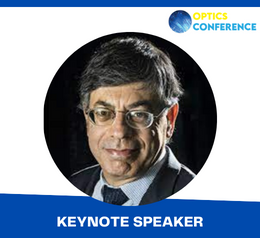Scholars 2nd Edition International Conference on
Optics, Lasers and Photonics
THEME: "A New Era towards Optics, Lasers & Photonics Technologies"
 27-28 Mar 2023
27-28 Mar 2023  Crowne Plaza Ealing, London, UK & Online
Crowne Plaza Ealing, London, UK & Online THEME: "A New Era towards Optics, Lasers & Photonics Technologies"
 27-28 Mar 2023
27-28 Mar 2023  Crowne Plaza Ealing, London, UK & Online
Crowne Plaza Ealing, London, UK & Online 
Federal Institute of Technology in Lausanne, Switzerland
Title: Integrated Quantum Photonics Using Site-Controlled Quantum Dots
Eli Kapon received his PhD in physics from Tel Aviv University, Israel, in 1982. After a postdoc at Caltech, where he investigated semiconductor lasers and laser arrays, he joined Bellcore in 1984, where he worked on integrated photonics and quantum nanostructures, demonstrating the first quantum wire lasers in 1988. Since 1993 he is professor of physics of nanostructures at EPFL, Switzerland, where he has worked on quantum wires and dots, photonic crystals, and vertical cavity surface emitting lasers. He is Fellow of the Optical Society of America, the American Physical Society and the Institute of electrical and Electronics Engineers.
Development of means for manipulation of quantum states of light on a chip constitutes an important platform for quantum information technologies. Attractive techniques for producing and controlling such states of light employ photon emission from semiconductor quantum dots (QDs) and their guidance using photonic crystal (PhC) cavities and wave-guides. This talk covers recent progress in the integration of site-controlled, pyramidal InGaAs/GaAs QDs with PhC structures nano-fabricated on GaAs chips. The fabrication of the structures consists first of growth of InGaAs/GaAs QDs emitting in the ~900nm wavelength inside pyramidal pits produced at prescribed locations on (111)B-oriented GaAs substrates using electron beam lithography, etching and organometallic vapor phase epitaxy. Various PhC cavities and wave-guides are then nano-fabricated around the QDs with positioning precision as good as ~20nm. The QDs are photo-excited at low temperatures and the photons emitted at various PhC nodes are analysed using optical spectroscopy. Several cavity-electrodynamics effects due to coupling into the PhC cavities are observed, including new features of the Purcell effect related to quantum interference among confined and radiation modes. Integration of such QDs with more complex PhC structures comprising coupled cavities and wave-guides for single-photon routing are presented and discussed.